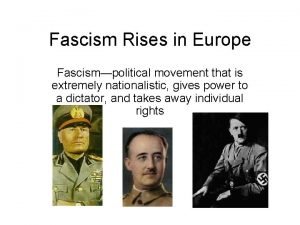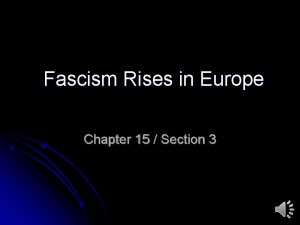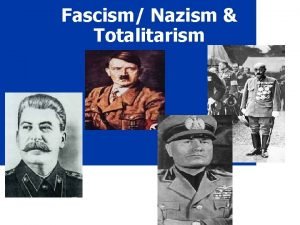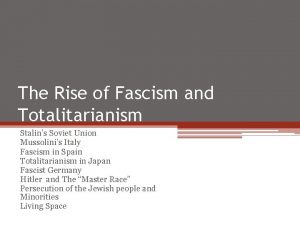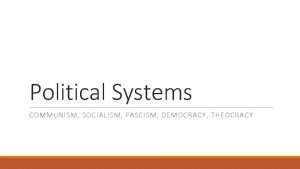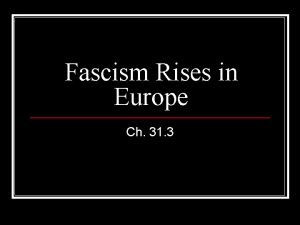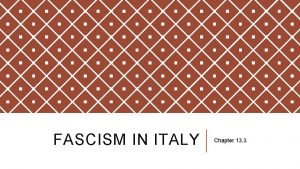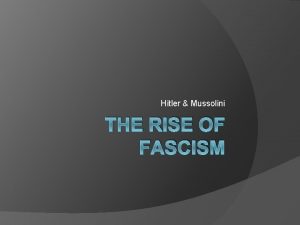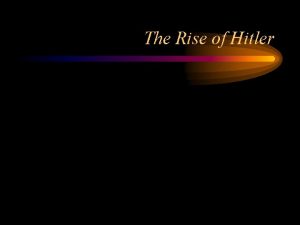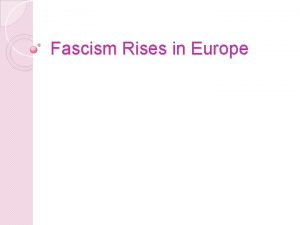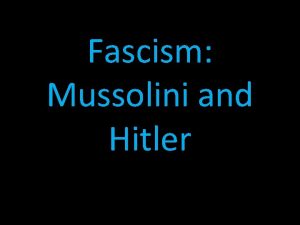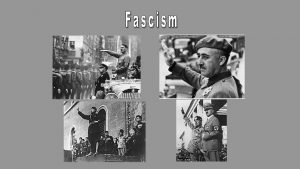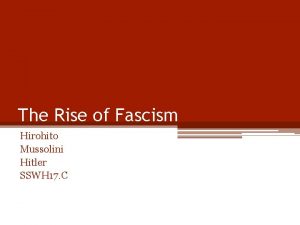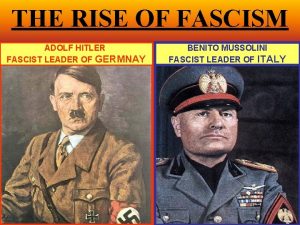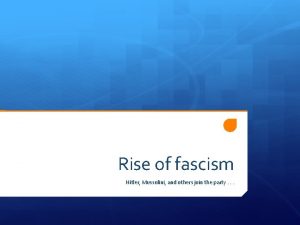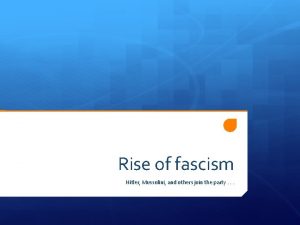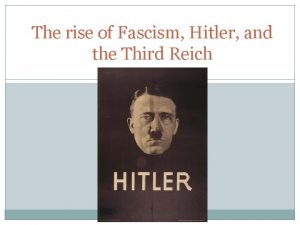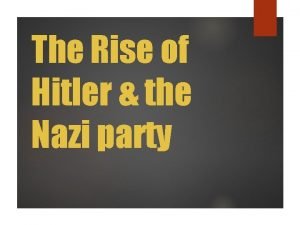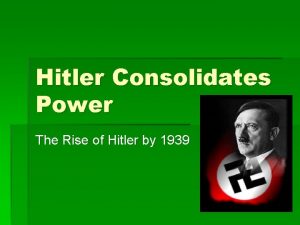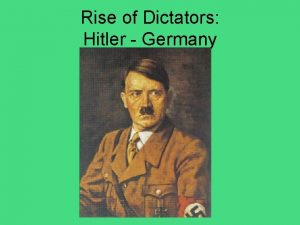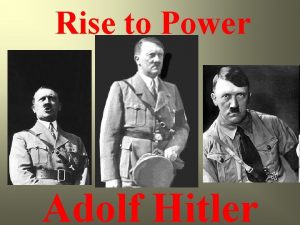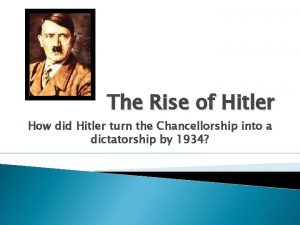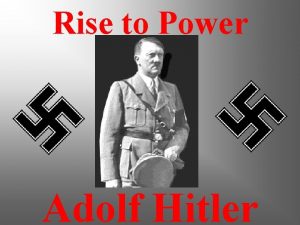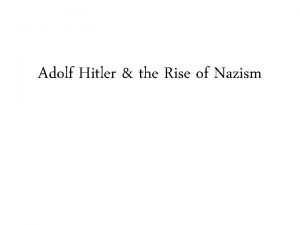Fascism The Rise of hitler What is Fascism
































































- Slides: 64

Fascism & The Rise of hitler

What is Fascism? • Fascism is a system of government developed by Benito Mussolini in 1919. • A fasces is a staff of office from the Roman Empire • The symbolism is obvious- bound together we are much stronger than individually. • As a symbol of fascism ithttp: //en. wikipedia. org/wiki/Image: Fasces. png was eventually replaced

Characteristics of Fascism • The system is an authoritarian, right wing, conservative system. • Dr. Laurence Britt, a Political Scientist compared fascist regimes and found that they all had 14 things in common.

Characteristics of Fascism 1. Powerful and Continuing Nationalism Fascist regimes tend to make constant use of patriotic mottos, slogans, symbols, songs, and other paraphernalia. Flags are seen everywhere, as are flag symbols on clothing and in public displays.

Characteristics of Fascism 2. Disdain for the Recognition of Human Rights Because of fear of enemies and the need for security, the people in fascist regimes are persuaded that human rights can be ignored in certain cases because of "need. " The people tend to look the other way or even approve of torture, summary executions, assassinations, long incarcerations of prisoners, etc.

Characteristics of Fascism 3. Identification of Enemies/Scapegoats as a Unifying Cause The people are rallied into a unifying patriotic frenzy over the need to eliminate a perceived common threat or foe: racial , ethnic or religious minorities; liberals; communists; socialists, terrorists, etc. 4. Supremacy of the Military Even when there are widespread domestic problems, the military is given a disproportionate amount of government funding, and the domestic agenda is neglected. Soldiers and military service are glamorized.

Characteristics of Fascism 5. Rampant Sexism The governments of fascist nations tend to be almost exclusively male-dominated. Under fascist regimes, traditional gender roles are made more rigid. Opposition to abortion is high, as is homophobia and anti-gay legislation and national policy. 6. Controlled Mass Media Sometimes to media is directly controlled by the government, but in other cases, the media is indirectly controlled by government regulation, or sympathetic media spokespeople and executives. Censorship, especially in war time, is very common.

Characteristics of Fascism 7. Obsession with National Security Fear is used as a motivational tool by the government over the masses. 8. Religion and Government are Intertwined Governments in fascist nations tend to use the most common religion in the nation as a tool to manipulate public opinion. Religious rhetoric and terminology is common from government leaders, even when the major tenets of the religion are diametrically opposed to the government's policies or actions.

Characteristics of Fascism 9. Corporate Power is Protected The industrial and business aristocracy of a fascist nation often are the ones who put the government leaders into power, creating a mutually beneficial business/government relationship and power elite. 10. Labor Power is Suppressed Because the organizing power of labor is the only real threat to a fascist government, labor unions are either eliminated entirely, or are severely suppressed.

Characteristics of Fascism 11. Disdain for Intellectuals and the Arts Fascist nations tend to promote and tolerate open hostility to higher education, and academia. It is not uncommon for professors and other academics to be censored or even arrested. Free expression in the arts is openly attacked, and governments often refuse to fund the arts. 12. Obsession with Crime and Punishment Under fascist regimes, the police are given almost limitless power to enforce laws. The people are often willing to overlook police abuses and even forego civil liberties in the name of patriotism. There is often a national police force with virtually unlimited power in fascist nations.

Characteristics of Fascism 13. Rampant Cronyism and Corruption Fascist regimes almost always are governed by groups of friends and associates who appoint each other to government positions and use governmental power and authority to protect their friends from accountability. It is not uncommon in fascist regimes for national resources and even treasures to be appropriated or even outright stolen by government leaders. 14. Fraudulent Elections Sometimes elections in fascist nations are a complete sham. Other times elections are manipulated by smear campaigns against or even assassination of opposition candidates, use of legislation to control voting numbers or political district boundaries, and manipulation of the media. Fascist nations also typically use their judiciaries to manipulate or control elections.

Mussolini was angry at the representation of Italy at the Treaty of Versailles in 1919. Italy was in trouble. The War had left them with huge inflation, a giant debt, massive unemployment, and a giant deficit. The standing constitutional monarchy was still very biased towards the rich and aristocratic, and only taxed the middle and lower classes.

Mussolini • There was rampant discontent. • Groups of soldiers called arditi had become a self-directed paramilitary group. • They took territories the Italians assumed they would get in the T. O. V.

Mussolini • The arditi were popular heroes. • They took to wearing black shirts and black fez hats. • Mussolini copied the uniform for his blackshirt followers.

Mussolini • A newspaper editor and writer, he was able to sway people and create interest in ideas effectively. • He was totally effective in gaining wide support. • When he and the fascists didn’t win in the elections in 1919, he resorted to violencebombs, delivered in the mail to opposition, thrown at marches for opposing groups.

Mussolini • He got a very light sentence. • Over the next few years he rose in power and popularity. • His tactics didn’t change, however. • Over the next few years, Mussolini slowly eradicated all other political parties from parliament, and Giacomo Matteotti, an outspoken Socialist and opponent of Mussolini ended up in a shallow grave.

Mussolini He attacked the Left and became quite powerful. He was able to unify a disparate group of Right wing groups into a group he called Facisti He made himself look more legitimate. He curbed the violence. He helped break up strikes, He formed coalitions with other parties. He got really powerful. In fear of a bloody civil war in the streets, the king, Victor Emmanuel III appointed him to the position of premiere.

Mussolini • He increased his power by employing his traditional methods, combining coalition forming with brutal violence. (Cheka) • He brokered the Lateran Agreement with the Church, • He started public works. • He got the GNP up with cooperation of businesses and government. • He was honored and revered for stopping socialism and bolshevism. • He named himself Il Duce and took over.

“Things are going to be bad for the Jews in Europe. ” Steps to The Holocaust

The 25 points • Hitler helped create the Nazi party (in German, the NSDAP). • In 1920 they released their party platform their intentions for the Jews were already very clear. http: //www. scrapbookpages. com/Nurnberg 04 A. html

The 25 points They included positions like; 1. Only a member of the race can be a citizen. A member of the race can only be one who is of German blood, without consideration of creed. Consequently no Jew can be a member of the race. 2. Whoever has no citizenship is to be able to live in Germany only as a guest, and must be under the authority of legislation foreigners.

The 25 points 3. The right to determine matters concerning administration and law belongs only to the citizen. Therefore we demand that every public office, of any sort whatsoever, whether in the Reich, the county or municipality, be filled only by citizens. There were many other ideas, like ending freedom of the press, ending immigration, ending judicial due process, and rebuilding the army.

The Kapp Putsch • Angry that they were going to be disbanded in the terms of the T. O. V. , the Freikorps marched on Berlin and occupied it, forcing the government to Dresden – (privately organized and funded armies. The troops were organized by Army officers from the Kaiser’s army and they defended the country against the influx of Communists and suppressed local rebellions. When they were disbanded in 1921, many of them became Sturmabteilung (a. k. a. brown shirts) in Hitler’s private militia. )

The Kapp Putsch • The Weimar government couldn’t defend itself so it called for a general strike to support the government which worked. • This event in 1920 shows how weak the government is, and that the Weimar Army and Govt. did not work well together.

Albert Leo Schlageter • German soldier, Nazi martyr. • Executed by French for tried to lead an armed assault to take the Ruhr back. • Hitler uses his death in 1923 to his advantage and creates a hero and adds fuel to the fire.

The Beer Hall Putsch • Beer halls were normal meeting places in Germany. • The Bürgerbräukeller was very large and the site of many NSDAP meetings. • Munich and Bavaria in general were in a state of political turmoil. But also were where a lot of really conservative groups were based. Bürgerbräukeller, site of the Beer Hall Putsch during a NSDAP meeting in 1923

The Beer Hall Putsch • Hitler and another conservative leader, Gustav Von Kahr were helping each other gain power, but when they had a falling out, Hitler marched to the beer hall where Von Kahr was speaking. • He and his men surrounded the beer hall, aimed a machine gun at the door and entered. • Hitler jumped on a table, stopped Von Kahr’s speech and yelled,

• “The national revolution has broken out! The hall is filled with six hundred men. Nobody is allowed to leave. The Bavarian government and the government at Berlin are deposed. A new government will be formed at once. The barracks of the Reichswehr and those of the police are occupied. Both have rallied to the swastika. ”

The Beer Hall Putsch • Hitler’s men were stationed all over the city. • They were to take other buildings and beer halls. • They arrested local Jews and foreigners. • They aimed to take over the government, and march on Berlin. • The next day, they exchanged fire with the police and 16 Nazis died. Hitler fled.

The Aftermath • Two days later, Hitler was arrested for high treason. • He was sentenced to 5 years, but only served 8 months. • While in prison he wrote his manifesto and gained support.

Hitler comes to power Jan. 1933 -Hitler named chancellor Feb. 1933 -Reichstag Fire Mar. 1933 -Enabling Act Aug. 1934 -President Hindenburg dies, Hitler takes both offices and calls himself Der Fuhrer 1935 -Nuremberg Laws issued

The Nuremberg Laws are broken into two parts, 1. The Laws for the Protection of German Blood and German Honor 2. The Reich Citizenship Law

The Nuremberg Laws Section 1 – Marriages between Jews and citizens (German: Staatsangehoerige) of German or kindred blood are forbidden. Marriages concluded in defiance of this law are void, even if, for the purpose of evading this law, they were concluded abroad. – Proceedings for annulment may be initiated only by the Public Prosecutor.

The Nuremberg Laws • Section 2 Extramarital sexual intercourse between Jews and subjects of the state of Germany or related blood is forbidden. Section 3 Jews will not be permitted to employ female citizens under the age of 45, of German or kindred blood, as domestic workers.

The Nuremberg Laws • Section 4 – Jews are forbidden to display the Reich and national flag or the national colors. – On the other hand they are permitted to display the Jewish colors. The exercise of this right is protected by the State. • Section 5 – A person who acts contrary to the prohibition of Section 1 will be punished with hard labor. – A person who acts contrary to the prohibition of Section 2 will be punished with imprisonment or with hard labor. – A person who acts contrary to the provisions of Sections 3 or 4 will be punished with imprisonment up to a year and with a fine, or with one of these penalties.

The Nuremberg Laws • Section 6 – The Reich Minister of the Interior in agreement with the Deputy Führer and the Reich Minister of Justice will issue the legal and administrative regulations required for the enforcement and supplementing of this law.

The Reich Citizenship Law Article I 1. A subject of the State is a person who belongs to the protective union of the German Reich, and who therefore has particular obligations towards the Reich. 2. The status of subject is acquired in accordance with the provisions of the Reich and State Law of Citizenship. Article 2 1. A citizen of the Reich is that subject only who is of German or kindred blood and who, through his conduct, shows that he is both desirous and fit to serve the German people and Reich faithfully. 2. The right to citizenship is acquired by the granting of Reich citizenship papers. 3. Only the citizen of the Reich enjoys full political rights in accordance with the provision of the laws. Article 3 The Reich Minister of the Interior in conjunction with the Deputy of the Fuhrer will issue the necessary legal and administrative decrees for carrying out and supplementing this law

Who is a Jew? • Anyone who had three or four grandparents who were Jewish were considered a first degree Jew. This was even if the had never practiced Judaism, or had converted to another faith.

Who is a Jew? If a Jewish person married a non-Jew their children were considered to be mixed blood. (mischling) The children were treated the same as Jews if both parents were of mixed blood, if they had an unusually Jewish appearance or if they had a police record or were a rebel.

Now what? • In 1933, the Nazi minister of propaganda, Joseph Goebbels, began to give speeches where he called Jews “a cancer on Germany” • In the spring, Jewish books are burned at public bonfires. "Where they have burned books, they will end in burning human beings. " (German: "Dort, wo man Bücher verbrennt, verbrennt man am Ende auch Menschen. ")— Heinrich Heine, from his play Almansor (1821)

Jewish Artists • Works by Jewish authors were burned • Works by authors against WWI were burned • Works by authors against fascism or for socialism were burned • Works of Jewish artists were burned

Boycott • In April, 1933 there was a great organized boycott of all Jewish businesses in Germany. • This is the first widespread overt governmental attack on Jewish businesses

They don’t just hate Jews • In 1933 they begin sterilizing those who were genetically undesirable to the Nazis. • Mentally and physically handicapped, mentally ill, epileptics, people with genetic diseases, blind and deaf people, alcoholics, and mixed race Germans were sterilized. • Gypsies became a prime target, along with homosexuals, Jehovah's Witnesses, communists and unionists.

It is getting worse! • In 1937 the first serious concentration camps were built. • In 1937 the first official order that allows for arrest and detention of asocial people, like the Jews and gypsies. • In August 1938, all Jewish men are forced to change their middle name to Israel and all Jewish women are forced to change their middle name to Sarah. • Their passports are stamped with a giant J. • In October all ‘stateless’ Jews are exiled to Poland

Kristallnacht TO ALL REGIONAL AND SUB-REGIONAL GESTAPO OFFICES sent at 1: 20 AM, November 8, 1938 SUBJECT: MEASURES AGAINST THE JEWS THIS NIGHT That only such measures were to be taken that would not endanger German lives or property (e. g. the burning of synagogues was only to be carried out if there was no danger of fire spreading to the surrounding district). Businesses and residences of Jews may be damaged but not looted. Particular care is to be paid in business sections and surrounding streets. Non-Jewish businesses are to be protected from damage under all circumstances. Police are to seize all archives from synagogues and offices of community organizations, this refers to material of historical significance. Archives are to be handed over to the SS. (Because the synagogues were to be burned to the ground, the Nazis wanted the records of the Jews. ) As soon as possible, officials are to arrest as many Jews especially wealthy ones - in all districts as can be accommodated in existing cells. For the time being, only healthy male Jews of not too advanced age are to be arrested. Signed by Reinhard Heydrich, SS Gruppenfürer

Kristallnacht • In November of 1938 on the 9 th-10 th there was an orchestrated German attack on Jewish businesses, homes, synagogues and cemeteries. • All Jewish firearms were confiscated and 30, 000 Jews were sent to camps. During Kristallnacht, the Night of Broken Glass, a synagogue burns in Siegen, Germany. November 10, 1938

The twisted steel vault of a huge synagogue in Bialystok. On June 27, 1941, the Nazis burned alive about 1, 000 Jews in this temple Germans pass by the broken shop window of a Jewishowned business that was destroyed during Kristallnacht in Berlin, Germany. The "night of broken glass" was a planned series of acts of violence against Jews throughout Germany. November 10, 1938. Jews arrested during Kristallnacht line up for roll call at the Buchenwald concentration camp.


The beginning-european prewar population of jews -9. 5 million http: //www. ushmm. org/

THE End-European postwar population of jews 3. 5 million http: //www. ushmm. org/

Concentration Camps

Concentration Camps

The Camps • The horizontal categories list markings for the following types of prisoners: (from left to right) political, professional criminal, emigrant, Jehovah's Witnesses, homosexual, Germans shy of work, and other nationalities shy of work. The vertical categories begin with the basic colors, and then show those for repeat offenders, prisoners in punishment kommandos, Jews who have violated racial laws by having sexual relations with Aryans, and Aryans who violated racial laws by having sexual relations with Jews. The remaining symbols give examples of marking patterns.

Article I. • (1. ) Anyone who suffers from an inheritable disease may be surgically sterilized if, in the judgment of medical science, it could be expected that his descendants will suffer from serious inherited mental or physical defects. • (2. ) Anyone who suffers from one of the following is to be regarded as inheritably diseased within the meaning of this law: – 1. congenital feeble-mindedness – 2. schizophrenia – 3. manic-depression – 4. congenital epilepsy – 5. inheritable St. Vitus dance (Huntington's Chorea) – 6. hereditary blindness – 7. hereditary deafness – 8. serious inheritable malformations • (3. ) In addition, anyone suffering from chronic alcoholism may also be sterilized.

Article II. • (1. ) Anyone who requests sterilization is entitled to it. If he be incapacitated or under a guardian because of low state of mental health or not yet 18 years of age, his legal guardian is empowered to make the request. In other cases of limited capacity the request must receive the approval of the legal representative. If a person be of age and has a nurse, the latter's consent is required.

Racial Biology (2. ) The request must be accompanied by a certificate from a citizen who is accredited by the German Reich stating that the person to be sterilized has been informed about the nature and consequence of sterilization. (3. ) The request for sterilization can be recalled. Under the sterilization program, 400, 000 Germans were sterilized.

Racial Biology • “On October 18, 1935, the Nazi government passed a third and final measure in this series, the Law for the Protection of the Genetic Health of the German People ("Gesetz zum Schutze der Erbgesundheit des Deutschen Volkes, " or Marital Health Law), requiring couples to submit to medical examination before marriage to see if "racial damage" might be involved; the law forbade marriage between individuals suffering from venereal disease, feeble-mindedness, epilepsy, or any of the other "genetic infirmities" specified in the 1933 Sterilization Law. Those considered genetically ill ("Erbkranken") were permitted to marry other genetically ill, but only after being sterilized to ensure that they would not leave any offspring. ” • http: //www. pbs. org/wnet/redgold/basics/racialhygiene. html

Eugenics • This all was under the umbrella of Eugenics, a popular paradigm at the time. • Popularized in America, it is the idea that you can improve the human race through controlled breeding.

This moved quickly into Euthanasia Slide taken from a Nazi propaganda filmstrip, promoting "euthanasia, " prepared for the Hitler Youth. The caption says: "Mentally ill Negro (English) 16 years in an institution costing 35, 000 RM [Reichsmarks]. " Photograph with the caption: ". . . because God cannot want the sick and ailing to reproduce. " This image originates from a film, produced by the Reich Propaganda Ministry, that aimed through propaganda to develop public sympathy for the Euthanasia Program

• Article III. Sterilization may also be recommended by: • (1. ) the official physician • (2. ) the official in charge of a hospital, sanitarium, or prison. • Article IV. The request for sterilization must be presented in writing to, or placed in writing by the office of the Health Inheritance Court. The statement concerning the request must be certified by a medical document or authenticated in some other way. The business office of the court must notify the official physician. Article VII. The proceedings of the Health Inheritance Court are secret. • Article X. The Supreme Health Insurance Court retains final jurisdiction.

What does a Jew look like? • According to Nazi scientists, Jews are different from Germans in different physical ways. 1. They are shorter- avg. man is 5’ 3” vs. 5’ 6. 2. They have shorter arms and legs in relationship to their torso. 3. Their hands and feet are often narrow.

What does a Jew look like? 4. Flabby, weak and nonathletic builds. 5. Flat feet 6. Eyes- ‘almond shaped’ round on inner corner, pointed outer corner. 7. Upper eyelids are thick and heavy. 8. Lower lip usually fleshy and larger than top lip. 9. Noses shaped like 6 s.

What does a Jew look like? 10. Fingerprints are different. 11. Dark curly hair, usually thinning on men. 12. Dark eyes. 13. Men have profuse body hair growth 14. More susceptible to disease. 15. Bad eyesight 16. Higher rates of schizophrenia Higher rates of hysteria and suicide.

 Why were italian nationalists outraged after ww1
Why were italian nationalists outraged after ww1 Nazi partys
Nazi partys The rise and fall of adolf hitler
The rise and fall of adolf hitler How did hitler rise to power
How did hitler rise to power Sheep become lions
Sheep become lions Richard nixon tricky dicky
Richard nixon tricky dicky Raise and rise again until lambs become lions
Raise and rise again until lambs become lions A union b example
A union b example Hổ đẻ mỗi lứa mấy con
Hổ đẻ mỗi lứa mấy con Lời thề hippocrates
Lời thề hippocrates đại từ thay thế
đại từ thay thế Quá trình desamine hóa có thể tạo ra
Quá trình desamine hóa có thể tạo ra Công thức tính thế năng
Công thức tính thế năng Hình ảnh bộ gõ cơ thể búng tay
Hình ảnh bộ gõ cơ thể búng tay Thế nào là mạng điện lắp đặt kiểu nổi
Thế nào là mạng điện lắp đặt kiểu nổi Dot
Dot Vẽ hình chiếu đứng bằng cạnh của vật thể
Vẽ hình chiếu đứng bằng cạnh của vật thể Thế nào là sự mỏi cơ
Thế nào là sự mỏi cơ độ dài liên kết
độ dài liên kết Các môn thể thao bắt đầu bằng từ đua
Các môn thể thao bắt đầu bằng từ đua Voi kéo gỗ như thế nào
Voi kéo gỗ như thế nào Khi nào hổ con có thể sống độc lập
Khi nào hổ con có thể sống độc lập Thiếu nhi thế giới liên hoan
Thiếu nhi thế giới liên hoan điện thế nghỉ
điện thế nghỉ Một số thể thơ truyền thống
Một số thể thơ truyền thống Trời xanh đây là của chúng ta thể thơ
Trời xanh đây là của chúng ta thể thơ Slidetodoc
Slidetodoc Số nguyên là gì
Số nguyên là gì Phối cảnh
Phối cảnh Các châu lục và đại dương trên thế giới
Các châu lục và đại dương trên thế giới Thế nào là hệ số cao nhất
Thế nào là hệ số cao nhất Thang điểm glasgow
Thang điểm glasgow ưu thế lai là gì
ưu thế lai là gì Hệ hô hấp
Hệ hô hấp Tư thế ngồi viết
Tư thế ngồi viết đặc điểm cơ thể của người tối cổ
đặc điểm cơ thể của người tối cổ Cái miệng xinh xinh thế chỉ nói điều hay thôi
Cái miệng xinh xinh thế chỉ nói điều hay thôi Cách giải mật thư tọa độ
Cách giải mật thư tọa độ Bổ thể
Bổ thể Tư thế ngồi viết
Tư thế ngồi viết Thẻ vin
Thẻ vin Thơ thất ngôn tứ tuyệt đường luật
Thơ thất ngôn tứ tuyệt đường luật Các châu lục và đại dương trên thế giới
Các châu lục và đại dương trên thế giới Chúa yêu trần thế
Chúa yêu trần thế Từ ngữ thể hiện lòng nhân hậu
Từ ngữ thể hiện lòng nhân hậu Diễn thế sinh thái là
Diễn thế sinh thái là Ví dụ giọng cùng tên
Ví dụ giọng cùng tên Vẽ hình chiếu vuông góc của vật thể sau
Vẽ hình chiếu vuông góc của vật thể sau 101012 bằng
101012 bằng Tỉ lệ cơ thể trẻ em
Tỉ lệ cơ thể trẻ em Capitalism communism socialism fascism
Capitalism communism socialism fascism Fascism rises in europe summary
Fascism rises in europe summary Fascism in italy worksheet answers
Fascism in italy worksheet answers Socialism vs communism
Socialism vs communism Sin 23°
Sin 23° 14 characteristics of fascism
14 characteristics of fascism Capitalism communism socialism fascism
Capitalism communism socialism fascism Fascism
Fascism Communism
Communism Fascism vs totalitarianism
Fascism vs totalitarianism Fascism vs totalitarianism
Fascism vs totalitarianism Chapter 15 section 3 fascism rises in europe
Chapter 15 section 3 fascism rises in europe Communism
Communism Struggle ch 31
Struggle ch 31 Fascism
Fascism



















































